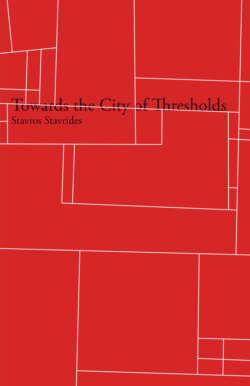Читать книгу Towards the City of Thresholds - Stavros Stavrides - Страница 23
На сайте Литреса книга снята с продажи.
From the city of enclaves to the city of thresholds
ОглавлениеMight not we consider these anti-enclosure movements as part of a multifarious and sometimes even contradictory effort to oppose the partitioning of city space? The measures taken during the 2003 Greek Presidency of the Council of the European Union or during the 2004 Olympic Games pushed the policy of fencing and controlling public space to its limits. The city center of Athens had become a highly controlled area, with temporary fences in many cases made permanent while police blocks proliferated.
By actively refusing to accept the erection of temporary nogo zones (red zones), protesters expressed their opposition to the ongoing partitioning and surveillance of public space. These multicolored blocks of young activists of “alter-globalization” movements expressly show that public space should be where different identities are allowed to communicate, meet, exchange ideas and longings, and interact. A city of thresholds sometimes emerges when public space is occupied, organized, and made porous by all these different people. Both symbolically and practically, these groups create an open-to-all public urban space.
If a new form of governance is tested in the temporary-permanent construction of red zones, a new form of emancipating culture is spontaneously tested in public space. In the migratory and ephemeral practices of social movements oriented towards urban demands, this potentially emancipating culture is ambiguously performed. The more these acts of essentially urban protest spread in the city, the more we can hope for passages to replace metastatic checkpoints. Perhaps instead of the “bourgeois utopia” of completely secure urban enclaves (Davis 1992), or the fantasy of identity-conferring ghettoes, we can see the emergence of porous public spaces: the heterotopias. An open city is a city of thresholds (Stavrides 2002, 2007).
Perhaps, in the renewed project of social emancipation, we can replace the rhythms that define checkpoints with those that define turning points. At these thresholds a new concept of time will emerge. A new epoch is thus marked by a critical rupture in social time. Walter Benjamin calls this “messianic time.” As we will see in chapter 3, Benjamin’s concept of time is based on the spatiotemporal experience of thresholds. His study of urban thresholds can become part of the project of researching the liberatory potential of threshold spatialities. In this context, we can imagine that a new kind of social time awareness will emerge as the polyrhythm of collective identities secreted into spaces of encounter.
1. Loïc Wacquant’s concept of “advanced marginality” attempts to understand contemporary ghettos as “isolated and bounded territories increasingly perceived by both outsiders and insiders as social purgatories, leprous badlands at the heart of the postindustrial metropolis” (Wacquant 2008, 237).
2. For Teresa Caldeira, contemporary São Paulo, one of the most segregated great cities in the world, is characterized by “a new pattern of urban segregation”; “the fortified enclaves … are privatized, enclosed, and monitored spaces for residence, consumption, leisure, and work” (Caldeira 2008, 65).
3. Bryan Turner understands “enclave society” as one in which “governments and other agencies seek to regulate spaces and, where necessary, to immobilize flows of people, goods and services” (Turner 2007, 290).
4. Atkinson and Blandy observe that gated communities are “characterized by legal agreements which tie the residents to a common code of conduct and (usually) collective responsibility for management” (Atkinson and Blandy 2005, 178; see also Minton 2009, 74–77).
5. The world is a floating “residential cruise liner,” the ultimate enclave of the super-rich (Atkinson and Blandy 2009, 92–110). “Moving out of public space, via gated communities and other secessionary modes of governance, has created places that are spatially embedded within, yet contractually outside many of the arrangement of state functions” (ibid., 108–109).
6. An analogous security “enclavism” is occurring in New York, especially after 9/11. Security zones define both public and private corporate buildings in ways that destroy public space (see Nemeth and Hollander 2010).
7. The Israeli wall is indeed a “temporary” security measure that is becoming permanent. “The Occupied Territories are trapped in a time loop where temporariness becomes permanent and exception becomes the rule, where no reality is fixed, no rules are clear, and no legal definition is stable” (Weizman 2005, 241).
8. For Kurt Iveson (who uses as an example the red zone created in Sydney in September 2007 during an APEC Leaders Meeting), “physical regulatory measures … far from being kept secret … were endlessly circulated through a wide range of media interventions” (Iveson 2009, 243). The protestors also used the media to their own means, to interrupt, expose, and fight the red zones: they thus “combined actions in the street with action on the screen” (ibid.).
9. Specifically, Turner (1977, 95) writes about “liminal entities,” “threshold people,” and “liminal personae.” Exemplary metropolitan rhythms and the city of enclaves
10. See Samatas (2007).
